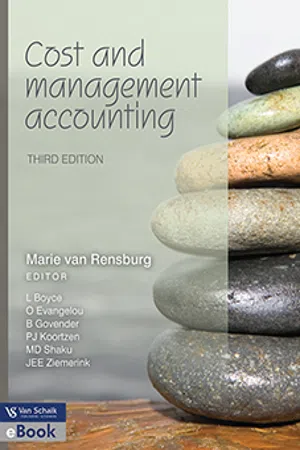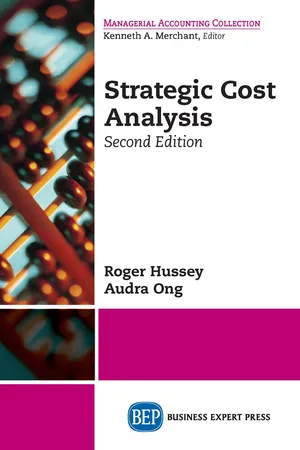Technology & Engineering
Standard Cost
Standard cost is a predetermined cost set for materials, labor, and overhead, which serves as a benchmark for evaluating actual costs. It is used to facilitate cost control, budgeting, and performance evaluation within a manufacturing or production environment. By comparing actual costs to standard costs, companies can identify variances and take corrective actions to improve efficiency and profitability.
Written by Perlego with AI-assistance
Related key terms
3 Key excerpts on "Standard Cost"
- eBook - ePub
- Van Rensburg M, Van Rensburg M(Authors)
- 2017(Publication Date)
- Van Schaik Publishers(Publisher)
The concepts of standards and costing systems apply to all types of organisation. 16.4 Setting standards Setting standards is one of the most difficult tasks in the establishment of a Standard Costing system. Historical data provide a good starting point for determining standards, but these must be adapted for changes in technology, production methods, and so on. Engineering studies and input from management, management accountants, production supervisors, the purchasing department, human resources department, as well as employees affected by the standards, are used for this purpose. A standard shows what should be, based on a certain set of anticipated circumstances. Effective standard setting requires the combined effort, experience, judgement and ability of everyone concerned to predict future trends. Standards are revised regularly even in fully established systems. 16.4.1 Direct material standards Three factors will influence the direct material standards, namely the quality of materials, quantity needed per product, and the purchase price of the material. The quality of the material is very important, as this will influence the quality of finished products, spoilage and, of course, the cost of the material. Other factors that influence the cost of material are the quantities purchased and (sometimes) the timing of the purchases. 16.4.2 Direct labour standards Direct labour standards are influenced by the type of work involved, the complexity of operations, employees’ skills level, the nature of the production process and the equipment used. Considering these factors, time measurements are made to determine the standard time needed by the average worker in the production of the product. Allowances should be made for unavoidable delays like machine breakdowns, idle time and routine maintenance. The standard labour rate is determined by company policy, skills level of employees and, possibly, negotiations with labour unions - eBook - ePub
- Roger Hussey, Audra Ong(Authors)
- 2018(Publication Date)
- Business Expert Press(Publisher)
To integrate usage and price, the Standard Cost is the planned unit of cost that is calculated from technical specifications and economic and market conditions. The technical specifications specify the quantity of materials, labor, and other elements of cost required, and these are then related to the prices and wages that are expected to be in place during the period when the Standard Cost will be used.To determine the appropriate standard for both usage and price of a resource, a careful analysis must be conducted on a range of information. To set standards for materials and labor, the organization will refer to the following:• Materials: quantity and price◦ Analysis of past data◦ Job specifications, which should list required materials◦ Engineering plans that provide a list of materials◦ Chemical formulas/formulae◦ Recipes or other documents specifying materials required◦ Time and motion studies◦ Price lists provided by suppliers◦ Expected economic environment◦ Predicted actions of suppliers, competitors, and customers• Labor: quantity (hours) and rate◦ Analysis of past data◦ Time and motion studies◦ Contracts that set labor rates◦ Prevailing rates in the area or industry◦ Expected economic environment◦ Changes in labor supply and demandAs a procurement manager, you can expect to be involved in the materials pricing standard. As an engineer, chemist, or production manager, you will assist with the quantity of the materials. Similarly with labor standards, a range of managerial knowledge and experience may be called in to assist in setting standards.At this stage, you will realize that standards are going to be set for the cost of the inputs, the labor, and the materials, and you therefore need to know the price for the inputs and the amount of usage for a certain level of production. The total cost of a particular input will be the amount used, multiplied by the price paid for a specific quantity of that output.Applying this principle, the use of 30 meters of a particular material at $2.00 per m, will have a total cost of $60.00.One difference in setting standards is that for labor. With this input, we are interested in the planned time that direct labor will take to complete a certain volume of work. This is usually measured in standard hours or standard minutes. The important point is that a standard hour is a measure of production output, rather than a measure of actual time. For example, a company may determine that 600 cost units should be produced in 1 hour. In a 7-hour day, the actual total production is 4,800 cost units. That actual output can be converted into standard hours as follows: - eBook - ePub
- Cristiano Antonelli, Albert Link(Authors)
- 2014(Publication Date)
- Routledge(Publisher)
Doing so greatly reduces the potentially high transaction costs associated with marketing technologically complex products. Such costs add to the price of products and thereby retard market penetration. 3.4 The economic context of standards The roles of product and non-product standards described above can only be fully understood in the context of the elements of the typical industrial technology—their investment patterns and how they interact to achieve commercially viable technologies. Specifically, modern industrial technologies are not “black boxes”. Rather, they consist of a number of discrete elements that tend to evolve in different market and institutional settings. These elements have unique characteristics and require different types and combinations of standards to achieve efficient development and utilization. Broadly defined, they fall into the three major categories shown in Figure 12.1 : “generic” or “platform” technologies (the fundamental technical concepts derived from basic science from which market applications are derived), “infratechnologies” (technical methods, techniques, data, and interfaces, which enable efficient conduct of R&D, production, and market transactions), and “proprietary” technologies (actual market applications developed by companies derived from platform technologies using infratechnologies). These technology elements, along with subsequent production, commercialization, and market development, are all affected by standardization, as shown in Figure 12.1. The thicker arrows indicate the direction of knowledge flows in a technology-based industry, with solid and compound stems indicating private-sector and public-sector produced knowledge, respectively. The thinner arrows indicate the points of impact on technology-based economic activity of each type of standard. This conceptual framework emphasizes the fact that “standards” are not a homogeneous or random collection of normative decisions
Index pages curate the most relevant extracts from our library of academic textbooks. They’ve been created using an in-house natural language model (NLM), each adding context and meaning to key research topics.


